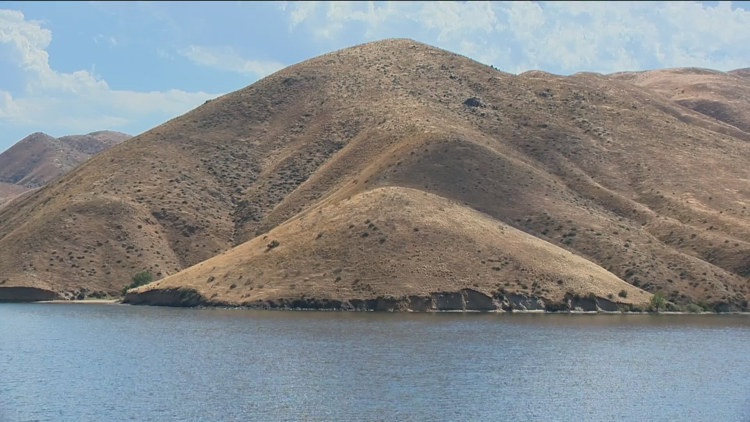BOISE, Idaho — This article originally appeared in the Idaho Press.
For the first time in more than three decades, Lucky Peak State Park will have updated classifications for management and land-use designation.
The park, which sees over a million visitors annually, will finally be getting a new master plan after going without an update since 1988. The draft changes reflect a continued effort to accurately recognize and maintain the park’s acreage that plays a significant role in the natural environment.
In a public hearing on the draft plan, U.S. Army Corps of Engineers officials reassured that the changes wouldn’t impact how visitors interact with the park. While it will bring changes to the way certain areas of the park are managed, visitors looking to enjoy the park’s recreational opportunities likely won’t see much difference.
“It’s more of an adjustment to the way we’re already managing … it’s not going to look any different than what we’re doing already,” Brett Call, U.S. Army Corps of Engineers master planner, said.
Among the biggest changes in the plan is the reduction in land designated for recreation alongside 641 acres newly designated as Environmentally Sensitive Areas (ESAs), a classification that didn’t exist under the prior plan.
RECREATION SHRINKING? NOT QUITE
The plan provides classification for two different types of recreation, both of which saw changes in the updated plan. Low-density recreation — such as hiking, sightseeing, biking and hunting — decreased from 713 acres to 196 acres. High-density recreation areas — such as camping sites, boat ramps and docks — decreased from 365 acres to 167 acres. While the numbers on the surface may indicate that recreation land is being “taken away,” the footprint of usable recreation acreage will nonetheless remain the same, Keith Hyde, U.S. Army Corps of Engineers natural resource specialist at Lucky Peak, said.
A significant portion of the areas once classified as low-density recreation will now be classified as wildlife management, recognized now for their importance in managing fish and wildlife resources. Low-density recreation will remain a secondary use for the land and visitors will still be able to participate in the activities that were previously enjoyed there.
Reductions in this designated acreage also stemmed from recognition that certain areas were inaccessible for their purported purpose. In some cases, the boundary for low-density recreation went up to a steep cliff that couldn’t be hiked or extended through an area that was too difficult to traverse. By tightening up boundaries that were initially painted with a “broad brush” decades ago, the acreage decreased to reflect where people were actually recreating, Hyde said.
The shift in high-density recreation stems from planners decades ago marking areas perceived to hold opportunity for future recreational expansion. In the years that followed, however, these areas would not be developed due to their restrictive landscapes not being conducive to such an undertaking.
“It was tracts of land almost impossible to develop into high-density recreation areas,” Call said. “We’ve kind of reduced those to a more realistic footprint.”
ENVIRONMENTALLY SENSITIVE AREAS
The biggest addition came in the form of ESAs, a new type of land classification that wasn’t present at the time the prior plan was drafted. These areas are protected for scientific and ecological reasons as well as for their cultural and aesthetic features. The vast majority of the acreage designated under this category was meant to address ecological concerns. Under the new plan, a significant elk and mule deer corridor — located just south of Robie Creek — will now have the ESA designation.
Lucky Peak’s Foote Park has also received ESA designation, in this case due to its cultural significance. The site was the former location of the Canyon House, that was designed and built by Arthur De Wint Foote in 1885. Today the site is a starting point for hiking and bird-watching, according to the draft plan documentation.
For these two areas, the primary effect of the ESA designation will be the ease of development projects in the area. In practice, if an internet company was looking to install wire through this area, they may only be able to do so during a certain time of the year that wouldn’t disturb wildlife or impede migration, Hyde said.
“Basically it just makes it a little bit harder to put any sort of infrastructure through there,” Hyde said. “Doesn’t make it impossible, but it’s going to face closer scrutiny.”
Like the aforementioned areas designated for wildlife management, the recreational activities that previously took place on ESAs will remain, Hyde said.
PUBLIC INPUT
“This kind of stuff, it’s not a prescription,” Hyde said. “It’s more of a concept, you know, where do we want to go in 20 years?”
The public will be able to provide input on the details of the plan through Nov. 30. The feedback — whether it be adjusting for a potential campground location, marking the presence of environmental features such as natural springs or notifying about the presence of rare flora and fauna — will be used to create a more accurate map and management plan for the park.
Being able to have access to the knowledge of environmental experts and long-time park visitors will help ensure the proposed adjustments accurately characterize the land and, in turn, maintain notable aspects of the park, Hyde said.
An interactive map of the Lucky Peak Master Plan is available on the U.S. Army Corps of Engineers website. The map will allow visitors to select a specific area of the park to direct their comments. Comments can be submitted via email to LuckyPeakMP@usace.army.mil. All submitted comments will be considered and be made public record.
This article originally appeared in the Idaho Press, read more on IdahoPress.com.



